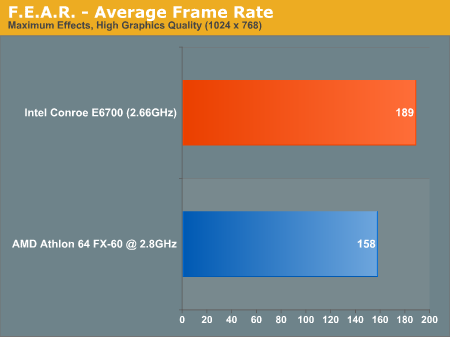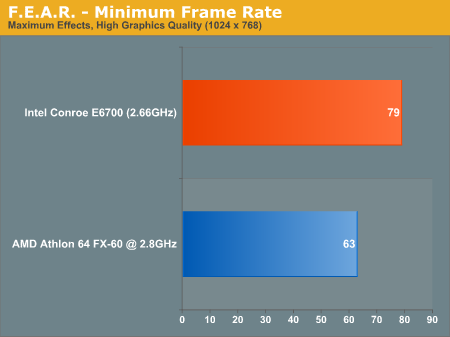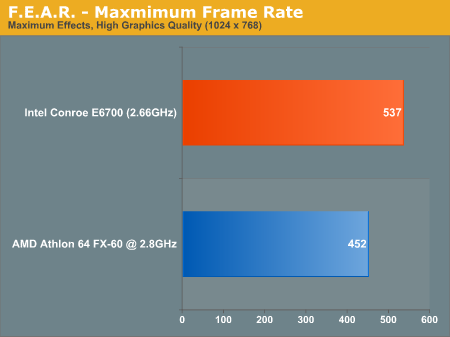Conroe Performance Preview Follow-Up
by Anand Lal Shimpi on March 9, 2006 9:30 AM EST- Posted in
- Trade Shows
The F.E.A.R. Issue
To the readers that pointed out our F.E.A.R. results as being unusually high, we owe you a sincere apology. When we went back to test Conroe for the second time we re-ran all of our tests to make sure that no mistakes were made. We caught the Quake 4 issue where Conroe’s SMP performance was understated, and we also discovered a problem in our F.E.A.R. testing.
While our intention was to test both the AMD and Intel systems at the “Maximum” Computer settings and “High” Graphics settings, only the Conroe system was configured as such. We inadvertently left the AMD system at a higher resolution (1280 x 960) instead of the default resolution (1024 x 768) when you select the “High” Graphics defaults. The oversight was entirely our own doing as Intel was not running the benchmarks or configuring them, it simply happened while we were setting up both systems at the same time. We played with different resolution settings and while deciding that we would go with one, managed to configure the two boxes differently.
Of course this means that our initial F.E.A.R. tests were incorrect, and below we have the correct results with the settings we intended to run both systems on:

The performance advantage of Conroe makes a lot more sense now, at 20% instead of 41%. With performance in Quake 4, UT2004 and HL2 in the 20 - 30% faster range on Conroe, the F.E.A.R. results now make a lot more sense.


To those who pointed out that even the CrossFire X1900 setup would be more GPU bound at 1280 x 960, you were very correct, our original results were inaccurate. We do strive for accuracy and reliability in our results here at AnandTech, which is why we went back and retested/confirmed all of our initial findings before bringing you this update. Aside from the F.E.A.R. and Quake 4 issues that we've since corrected, we found no other performance anomalies in our initial results.










96 Comments
View All Comments
Shintai - Thursday, March 9, 2006 - link
So to summon up with updated benchies, bios etc.Conroe 2.67Ghz beats the 2.8Ghz FX with:
Quake(intel demo) Single 22.4%
Quake(intel demo) SMP 24.8%
Quake(Anand demo) Single 28.7%
Quake(Anand demo) SMP 30.9%
FEAR - min 25.4%
FEAR - max 18.8%
FEAR - avg 19.6%
WMV9 12%
DiVX 6.1 29.5%
iTunes 6.0.1.3 9.7%
UT2004 and HL2 in the 20 - 30% faster range aswell on Conroe according to Anand. But if Intel was mean, they bench this FX with a 3.33Ghz Conroe XE or a 3.0Ghz Woodcrest.
And funny to see Intels dualcore implementation scales better than AMDs.
530$ to get that much more performance than a 1000$ FX chip.
Hell, even the 420$ and maybe 295$ chip is faster.
Both Conroe and AM2 gets DDR-2 800 at retail.
dysonlu - Sunday, March 12, 2006 - link
"530$ to get that much more performance than a 1000$ FX chip.Hell, even the 420$ and maybe 295$ chip is faster."
So, where can I order this amazing 530$ CPU?
It gets on my nerve to see people comparing prices between a computer part that's 6 months away from shipment and one that's shipping now.
Chadder007 - Thursday, March 9, 2006 - link
Thanks for the update....just shows us that Intel wasn't fooling around.Even after the BIOS update, the Conroe pounds the fool out of the FX-60. Also I doubt any other changes can help with the AMD performance either, even a chipset upgrade.
plus - Thursday, March 9, 2006 - link
So the Conroe is 20% faster. Decent result. Of course, the FX60 is on the 90NM process... will be interesting to see what 65NM process brings to the FX series... AMD is due to have that out about the time Conroe is released.Intel always seems to compare best to AMD when they are one shrink ahead. Tells a lot about the strength of the Athlon core.
I didn't see in the article if the Conroe is 64 bit. I've been running winXP64pro since Steam began auto-detecting 64bit capacity... It does seem to run smoother.
Plus
Eris23007 - Thursday, March 9, 2006 - link
Furthermore, to add on to the last post in this reply chain, Intel has already announced a transition to 45nm in 2007 - not long after AMD will have their first 65nm chips.
I've been predicting this for a while: AMD has been doing some excellent architectural work, but a good CPU is more than just architecture: the CMOS manufacturing process guys are of equal, if not greater importance. This is also where Intel has their biggest advantage: their CMOS manufacturing excellence is simply unparalleled both in quality and quantity. Say what you will about their architectural choices, but when is the last time you remember Intel failing to pull of a process shrink transition?
coldpower27 - Thursday, March 9, 2006 - link
AMD 65nm products isn't due till 1st Half of 2007. It's also AMD own fault that they are 3-4 Quarters behind Intel typically on process transistions. So hence Intel has 65nm products to show sooner then AMD can. Hence comparisons to AMD's 90nm products are legitimate.Intel's Core Micro-architecture have EM64T by default. This is obvious, you actually think Intel won't include such a thing when basically the bulk of shipping Pentium 4's and Celeron D have it now.
You have to remember the FX 60 was overclocked to 2.8GHZ and the Conroe @ 2.66GHZ beat it by 20% on average, what happens when you use the Conroe XE 3.0GHZ+/1333FSB edition agains the Athlon FX.
spinportal - Wednesday, March 22, 2006 - link
Actually the Pentium D and Xeon lines have EMT64, the Yonah - DuoCore processors do not.So we need real price points, with a comparable 939 NF4 AMD rig on XP64 or Vista-64 Beta2.
But where is the 64-bit push? All hoopla and not worth the aggravation of adoption?
anandtechrocks - Thursday, March 9, 2006 - link
20% from a CPU alone is a decent result? When is the last time you have gotten 20% performance increase from a new processor? I think the results are amazing, expecially this early in the game.porkster - Thursday, March 9, 2006 - link
How well does the amazing Conroe overclock? Were you allow to test that?Nighteye2 - Thursday, March 9, 2006 - link
The EE conroe will of course perform a bit better with higher clock speeds, but with the bus limiting it and only so much cache to try to circumvent that I don't expect conroe to scale very well. I'd also like to see 64-bit performance, as the bigger instructions will reduce the advantage of the large cache.